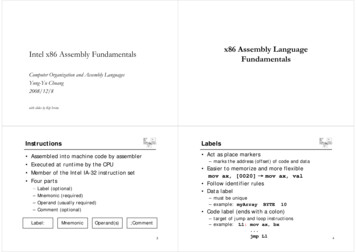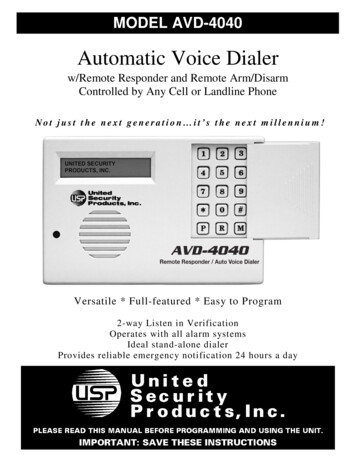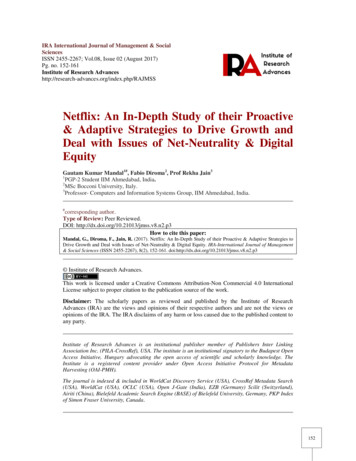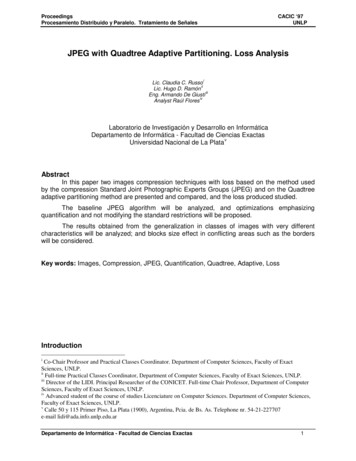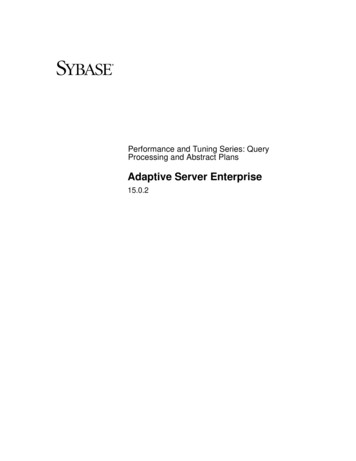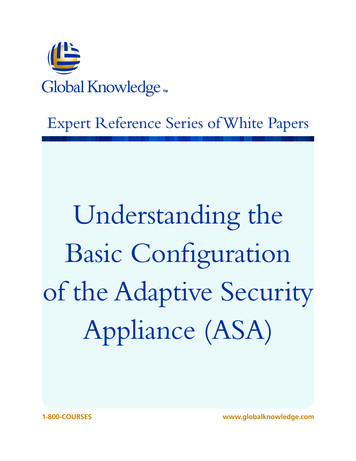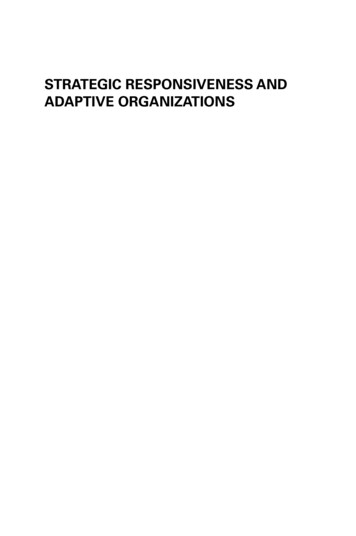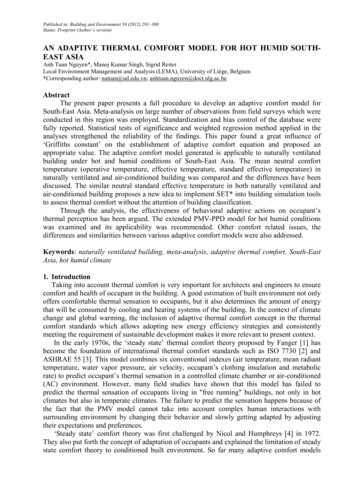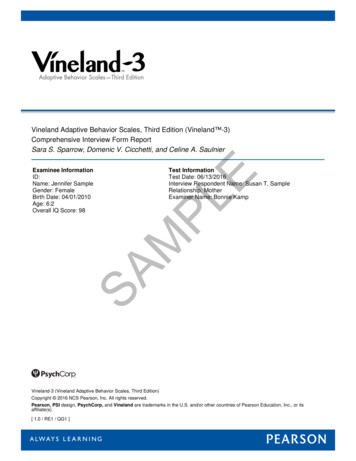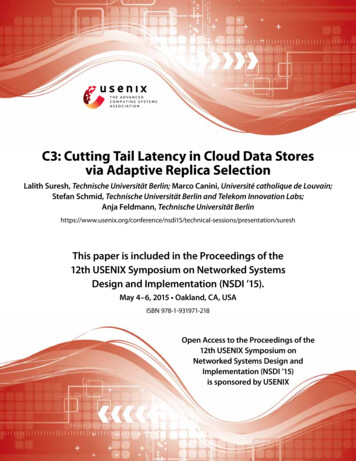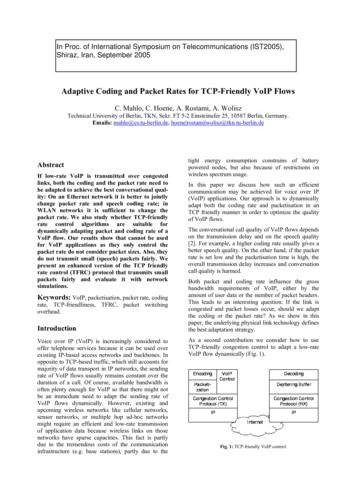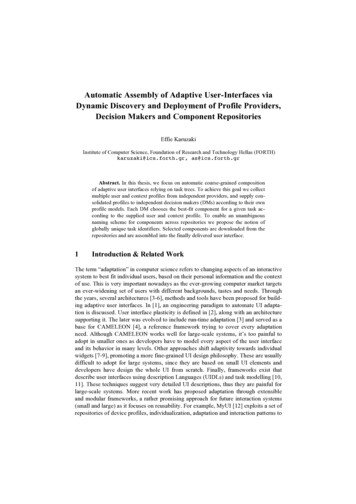
Transcription
Automatic Assembly of Adaptive User-Interfaces viaDynamic Discovery and Deployment of Profile Providers,Decision Makers and Component RepositoriesEffie KaruzakiInstitute of Computer Science, Foundation of Research and Technology Hellas (FORTH)karuzaki@ics.forth.gr, as@ics.forth.grAbstract. In this thesis, we focus on automatic coarse-grained compositionof adaptive user interfaces relying on task trees. To achieve this goal we collectmultiple user and context profiles from independent providers, and supply consolidated profiles to independent decision makers (DMs) according to their ownprofile models. Each DM chooses the best-fit component for a given task according to the supplied user and context profile. To enable an unambiguousnaming scheme for components across repositories we propose the notion ofglobally unique task identifiers. Selected components are downloaded from therepositories and are assembled into the finally delivered user interface.1Introduction & Related WorkThe term “adaptation” in computer science refers to changing aspects of an interactivesystem to best fit individual users, based on their personal information and the contextof use. This is very important nowadays as the ever-growing computer market targetsan ever-widening set of users with different backgrounds, tastes and needs. Throughthe years, several architectures [3-6], methods and tools have been proposed for building adaptive user interfaces. In [1], an engineering paradigm to automate UI adaptation is discussed. User interface plasticity is defined in [2], along with an architecturesupporting it. The later was evolved to include run-time adaptation [3] and served as abase for CAMELEON [4], a reference framework trying to cover every adaptationneed. Although CAMELEON works well for large-scale systems, it’s too painful toadopt in smaller ones as developers have to model every aspect of the user interfaceand its behavior in many levels. Other approaches shift adaptivity towards individualwidgets [7-9], promoting a more fine-grained UI design philosophy. These are usuallydifficult to adopt for large systems, since they are based on small UI elements anddevelopers have design the whole UI from scratch. Finally, frameworks exist thatdescribe user interfaces using description Languages (UIDLs) and task modelling [10,11]. These techniques suggest very detailed UI descriptions, thus they are painful forlarge-scale systems. More recent work has proposed adaptation through extensibleand modular frameworks, a rather promising approach for future interaction systems(small and large) as it focuses on reusability. For example, MyUI [12] exploits a set ofrepositories of device profiles, individualization, adaptation and interaction patterns to
Fig. 1. The overall system architecture (gray box).achieve UI adaptation during use, focusing on accessibility. MyUI supposes a common format for all design patterns and a common format among adaptation rules.Collecting user and context information is an important part of the adaptation process. Towards this direction, many approaches have been proposed in the literature,utilizing common user and context models among the profile providers and the respective consumers. In the context of semantic web, the FOAF (Friend of a friend)ontology has been proposed for describing persons and their activities in a uniformmanner. Although it has had limited adoption on the web1, many propositions [13-15]are based on it for consolidating multiple user profiles. Virtual User Modelling andSimulation Standardisation project cluster [16] define a common vocabulary to avoidconfusion among relative terms and user characteristics. Finally, [17] presents anapproach for merging generic user and context profiles based on given priorities.In our approach, application developers provide a coarse-grained task tree. Theterm coarse-grained is used to denote our focus on comprehensive dialogue components rather than on individual widgets. For the adaptive tasks, decision makers(DMs) select the most fitting UI components and we use them to assemble an adaptedUI. DMs, Profile Providers and UI components can be developed externally and registered to our system repositories. The overall architecture is given in Fig.1, where thesystem backbone is depicted as a gray box. Notice that the application optionally hasan internal UI in addition to the one assembled by our system. Additionally, an optional internal decision making mechanism is used to cover content adaptation thatthisdissertationaimstoachieve: mindependentdistrib- rofileandaunifiedcon- uteddecisionmakers,with- .1http://en.wikipedia.org/wiki/FOAF (ontology)
ntextprofiles. ponentsbasedoncoarse- isideatolife.3Distributed Profile ManagementAdaptation relies on user and context profiles. Today, user information can be retrieved from existing profiles in applications, social networks etc. The context of usecan be retrieved from several services (e.g. gps) and sensors. We propose a mechanism for collecting and merging user and context profile information from distributedproviders into a unified user profile and a unified context profile, while enabling providers to keep their own profile models and allowing user control over the retrievedinformation. No common models among the DMs or profile providers are supposedeither. For example, a provider may refer to user hobbies as “user.hobbies”, anotherone as “user.interests”, while a DM may require it as “personal info.free time”. EachDM passes their model to the profile manager and the latter translates, transforms andmerges the acquired profiles into unified ones that will conform to the DM’s model. Alexicon web service is used to provide synonyms for both model and profiles’ attributes. Synonyms in the model are then matched to synonyms in profiles, and commonones indicate matching of attributes, e.g. “interests” matches “hobbies”. Because attributes may have different meanings based on the profile structure, e.g. “name” canbe found under “user.name” or “user.pet.name”, DMs should also provide a set ofrules describing the alternative acceptable structures for each attribute that may beconflicted. The profile manager then uses the common synonyms along with thestructure rules to produce a unified profile that matches the given DM model (Fig.2).Fig. 2. Profile translation and transformation according to a given model
4Task Model and Distributed Decision MakingAdaptive applications allow the realization of a task in alternative ways, depending onuser and context profiles. We propose the assembly of adaptive user interfaces basedon task trees, where one or more tasks can be realized via a user interface componentretrieved from a repository. To avoid mismatches of tasks across components, weintroduce the notion of globally unique task identifiers (GUTIDs). Tasks can be eitheradaptive, i.e. be realized through alternative UI components, or non-adaptive, i.e.bound to predefined components specified by the application developer. Adaptivetasks are assigned to a DM to find the UI component best matching the user and context needs. Thus, two challenges are raised: i) how to rate DMs, i.e. choose the DMthat exploits most of the provided profiles while covering most of its model; and ii)how a DM can choose a UI component fitting the given application task tree. For thefirst challenge, a DM rating process is proposed (Fig.3). The idea is to rate the DMsbased on two metrics, coverage and utilization. Utilization is produced per DM by theprofile manager and refers to the percentage of the available profile information utilized by the given DM model. Coverage is computed by the given DM to reflectwhether the information found in providers is enough for making good adaptationdecisions. An equation provided by the application is then used to compute the finalscore. For the second challenge, a set of criteria must be met, first being the coverageof the given task. UI components have their own sub-task tree, which should matchthe application task tree and provide suitable hooks to allow further UI composition.Components are also expected to implement the API required by the application forthe given tasks, ensuring their proper linkage to the application core. Finally, DMscontain rules expressing the adaptation logic for suggesting the component best fittingFig. 3. The process of choosing a suitable decision maker
Fig. 4. An example of UI synthesis based on task trees.the given profiles. No restrictions about the rule representation or the implementationlanguage are posed; however, all DMs have to be registered in a directory, exposetheir capabilities and implement a common API to allow their uniform handling.5User Interface assemblyOnce suitable components are selected for all adaptive tasks, we can proceed in assembling the final UI. In Fig.4, an example UI synthesis is sketched: T1 is a nonadaptive task, thus bound to a specific component (A). (A) must have hooks to enableother UI components to be attached under T1 and T2. Conversely, T4 is adaptive, thuscan be covered by alternative UI components (B and C). Our system finds a suitableDM to pick the best fitting component for this task, say component B. Thus, comp. Bis downloaded from its repository and linked to the corresponding hook (T4 hook)inside comp. A. Tasks 6, 7, 10 and 11 are not covered yet, so our system repeats thecomponent-finding process until all application tasks correspond to a UI component.UI components deliver parts of a user interface which can be reused by other appsto cover specific UI needs. Each UI component is tagged as top-level, contained orboth, reflecting the type of the top-level container they use (in java it would beJFrame or JPanel). All components need to implement a common interface (API) toenable their uniform handling. Their implementation may be hand-written or derivedfrom UI generator tools. It is part of this thesis is to provide directions to generatorsfor producing components compatible with our system. Components should be registered in component repositories, carrying metadata describing the task(s) they deliver,the platform they target, the URL for downloading their binaries, etc. Repositories canbe distributed as well, with some of them even being private. Finally, a directory service will provide information about which components reside in each repository.6Current progress and further researchThe presented work is a thesis started three years ago (February 2011) and will becompleted in the next 16 months. Currently, the entire system has been carefully designed and a profile manager for user profiles retrieved from social networks is devel-
oped. Algorithms for finding and ranking DMs and the syntax for describing matching tree structures have been sketched, and we have experimented with prototype testcases in Java (Desktop & Android) for UI synthesis. To this end, UI components (realized as jars) are downloaded from a URL and are assembled together into a final UI.Further work remains to be done for the implementation of context profile utilization, decision making, dynamic component discovery and automatic UI assemblybased on task trees, including matching component sub-task trees to the applicationtask tree. Open research questions include ways in which the decision makers willrefer to UI components, what properties each UI component will have and what information should a GUTID contain. Further research includes enabling run-time UIcomponent substitution, ultimately targeting to dynamic and on-demand UI creation.7References1. Savidis, A., Stephanidis, C., (2004) Unified user interface development: the software engineering of universally accessible interactions. UAIS (3-4) (pp 165-193) (2004)2. Thevenin, D., Coutaz, J. (1999) Plasticity of User Interfaces: Framework and ResearchAgenda. Interact99, (pp. 110–117)3. Calvary, et.al. (2003). A Unifying Reference Framework for Multi-Target User Interfaces,IWC 15(3) (pp. 289-308).4. Calvary, G. et al(2002) The CAMELEON Reference Framework, Deliverable D1.15. Jaquero,V., Vanderdonckt, J., Montero, F., González,P. (2008). Towards an ExtendedModel of User Interface Adaptation: The ISATINE Framework. IFIP (pp. 374–392)6. (1992)Arch: A Metamodel for the Runtime Architecture of An Interactive System, TheUIMS Developers Workshop, SIGCHI Bulletin, 24(1), ACM Press7. Calvary, G. et al (2004). Towards a new generation of widgets for supporting softwareplasticity: the “comet”. EHCI-DSVIS, (pp. 306-324)8. Jabarin, B., T. C. Graham, N. (2003) Architectures for Widget-Level Plasticity. DSV-IS2003.9. Crease, M., Gray, P., Brewster, S., (2001). A Toolkit of Mechanism and Context Independent Widgets, Proceedings of DSVIS, (pp. 127-141)10. Paterno, F., Mancini, C., Meniconi, S. (1997). ConcurTaskTrees: A Diagrammatic Notation for Specifying Task Models, INTERACT ’97 (Pages 362 – 369)11. Pribeanu, C. (2005). An Approach to Task Modeling for User Interface Design. WEC(5)5-8.12. Peissner, M., Häbe, D., Janssen, D., Sellner, T. (2012). MyUI: Generating Accessible UserInterfaces from Multimodal Design Patterns. EICS ’12 (pp. 81-90).13. Golbeck, J., & Rothstein, M. Linking social networks on the web with FOAF: a semanticweb case study. In AAAI’08 (pp. 1138–1143). AAAI Press (2008).14. Raad, E., Chbeir, R., & Dipanda, A. User Profile Matching in Social Networks. InNBiS’10 pp. 297–304, (2010)15. Orlandi, F., Breslin, J., & Passant, A. Aggregated, interoperable and multi-domain userprofiles for the social web. SEMANTICS ’12 p. 41 (2012).16. Kaklanis, N, et al. An Interoperable and Inclusive User Modelling concept for Simulationand Adaptation. In Proceedings of the 20th UMAP (2012).17. Bettini, C., & Riboni, D. Profile aggregation and policy evaluation for adaptive internetservices. In MOBIQUITOUS 2004, pp. 290–298 (2014)
An example of UI synthesis based on task trees. oped. Algorithms for finding and ranking DMs and the syntax for describing match-ing tree structures have been sketched, and we have experimented with prototype test cases in Java (Desktop & Android) for UI sy
